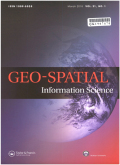- 钛学术文献服务平台 \
- 学术期刊 \
- 基础科学期刊 \
- 天文学、地球科学期刊 \
- 地球空间信息科学学报(英文版)期刊 \
Understanding the pattern and mechanism of spatial concentration of urban land use, population and economic activities:a case study in Wuhan, China
Understanding the pattern and mechanism of spatial concentration of urban land use, population and economic activities:a case study in Wuhan, China
基本信息来源于合作网站,原文需代理用户跳转至来源网站获取
摘要:
Quantifying the aggregation patterns of urban population, economic activities, and land use are essential for understanding compact development, but little is known about the difference among the distribution characteristics and how the built environment influences urban aggre-gation. In this study, five elements are collected in Wuhan, China, namely population density, floor area ratio, business POIs, road network and built-up area as the representative of urban population, economic activities and land use. An inverse S-shape function is employed to fit the elements' macro distribution. An aggregation degree index is proposed to measure the aggregation level of urban elements. The kernel density estimation is used to identify the aggregation patterns. The spatial regression model is used to identify the built environment factors influencing the spatial distribution of urban elements. Results indicates that all urban elements decay outward from the city center in an inverse S-shape manner. The business Point-of-Interest (POI) density and population density are highly aggregated;floor area ratio and road density are moderately aggregated, whereas the built-up density is poorly aggregated. Three types of spatial aggregation patterns are identified:a point-shaped pattern, an axial pattern and a planar pattern. The spatial regression modeling shows that the built environment is associated with the distribution of the urban population, economic activities and land use. Destination accessibility factors, transit accessibility factors and land use diversity factors shape the distribution of the business POI density, floor area ratio and road density. Design factors are positively associated with population density, floor area ratio and built-up density. Future planning should consider the varying spatial concentration of urban population, economic activities and land use as well as their relationships with built environment attributes. Results of this study will provide a systematic understanding of aggregation of urban land use, popula-tion, and economic activities in megacities as well as some suggestions for planning and compact development.

推荐文章
Effects of slope position and land use on the stability of aggregate-associated organic carbon in ca
Soil organic carbon
Aggregate fraction
Land use
Slope position
Karst
Southwest China
Spatial analysis of carbon storage density of mid-subtropical forests using geostatistics: a case st
Carbon storage density
Geostatistics
Mid-subtropical forests
Spatial autocorrelation
Spatial heterogeneity
Characteristics of heavy metals in soils under different land use in a typical karst area, Southwest
Heavy metals
Soil organic carbon
Land use
Karst
Southwest China
内容分析
关键词云
关键词热度
相关文献总数
(/次)
(/年)
文献信息
| 篇名 | Understanding the pattern and mechanism of spatial concentration of urban land use, population and economic activities:a case study in Wuhan, China | ||
| 来源期刊 | 地球空间信息科学学报(英文版) | 学科 | |
| 关键词 | |||
| 年,卷(期) | 2021,(4) | 所属期刊栏目 | Articles |
| 研究方向 | 页码范围 | 678-694 | |
| 页数 | 17页 | 分类号 | |
| 字数 | 语种 | 英文 | |
| DOI | |||
五维指标
引文网络
引文网络
二级参考文献 (0)
共引文献 (0)
参考文献 (0)
节点文献
引证文献 (0)
同被引文献 (0)
二级引证文献 (0)
2021(0)
- 参考文献(0)
- 二级参考文献(0)
- 引证文献(0)
- 二级引证文献(0)
引文网络交叉学科
相关学者/机构
期刊影响力
地球空间信息科学学报(英文版)
主办单位:
武汉大学(原武汉测绘科技大学)
出版周期:
季刊
ISSN:
1009-5020
CN:
42-1610/P
开本:
16开
出版地:
武汉市珞瑜路129号武汉大学测绘校区
邮发代号:
创刊时间:
1998
语种:
eng
出版文献量(篇)
958
总下载数(次)
0
总被引数(次)
2719
期刊文献
相关文献
推荐文献
- 期刊分类
- 期刊(年)
- 期刊(期)
- 期刊推荐
力学
化学
地球物理学
地质学
基础科学综合
大学学报
天文学
天文学、地球科学
数学
气象学
海洋学
物理学
生物学
生物科学
自然地理学和测绘学
自然科学总论
自然科学理论与方法
资源科学
非线性科学与系统科学
地球空间信息科学学报(英文版)2022
地球空间信息科学学报(英文版)2021
地球空间信息科学学报(英文版)2020
地球空间信息科学学报(英文版)2019
地球空间信息科学学报(英文版)2018
地球空间信息科学学报(英文版)2017
地球空间信息科学学报(英文版)2016
地球空间信息科学学报(英文版)2015
地球空间信息科学学报(英文版)2014
地球空间信息科学学报(英文版)2013
地球空间信息科学学报(英文版)2012
地球空间信息科学学报(英文版)2011
地球空间信息科学学报(英文版)2010
地球空间信息科学学报(英文版)2009
地球空间信息科学学报(英文版)2008
地球空间信息科学学报(英文版)2007
地球空间信息科学学报(英文版)2006
地球空间信息科学学报(英文版)2005
地球空间信息科学学报(英文版)2004
地球空间信息科学学报(英文版)2003
地球空间信息科学学报(英文版)2002
地球空间信息科学学报(英文版)2001
地球空间信息科学学报(英文版)2000

 免费查重
免费查重










